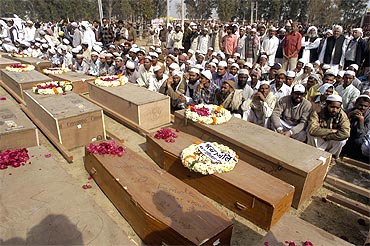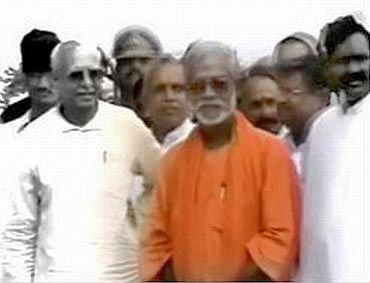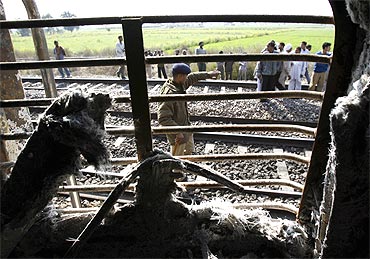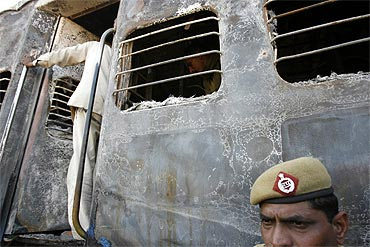 | « Back to article | Print this article |
'Bomb ka badla bomb', believed Aseemanand: NIA chargesheet
Capping four years of probe, the National Investigation Agency on Monday charged Swami Aseemanand and four others with triggering explosions in the cross-border Samjhauta Express in 2007 that left 68 people dead.
In the charge sheet filed before the Special Court in Panchkula, Haryana, the NIA accused Aseemanand, Sunil Joshi (now dead), Lokesh Sharma, Sandeep Dange and Ramchandra Kalasangra alias Ramji of hatching a criminal conspiracy which resulted in bomb blasts in the Samjhauta Express near Panipat on February 18, 2007.
Majority of those killed in the blast were Pakistanis.
The NIA investigation has claimed that Aseemanand was quite upset with the Jihadi/terrorist attacks on Akshardham temples in Gujarat, Raghunath temple in Jammu and Sankat Mochan temple in Varanasi.
'Bomb ka badla bomb'
"He used to vent his feelings while discussing these cases with Sunil Joshi and his associates. Over a period of time, they developed a deep vengeance against not only the Jihadi terrorists but unfortunately against the entire minority community as such," the NIA chargesheet said.
"As a result, Aseemanand propounded a bomb ka badla bomb (bomb for bomb) theory. Samjhauta train was particularly chosen, as most of the passengers who travel in it are Pakistani citizens. Aseemanand not only provided financial and logistical support to the terror group which executed this dastardly act but also played a vital role in instigating and motivating his associates to undertake this terrorist act," the chargesheet said.
The bi-weekly Samjhauta Express, which runs between Delhi and Lahore, plays a vital role in improving people-to-people contacts between India and Pakistan.
The NIA said Sandeep Dange, Ramji, Lokesh Sharma and others -- under the leadership of Sunil Joshi -- were instrumental in not only procuring the raw material for IED but also getting these fabricated and planted in the target.
'Blasts resulted in the loss of 68 lives'
"This blast and the consequent fire in the train coaches resulted in the loss of 68 lives and injuries to 12 train passengers including women and children travelling in the train. In this terror strike, not only Indian civilians and government officials got killed and injured, but a large number of Pakistani nationals who were passengers also lost their lives," the NIA charge sheet said.
The explosion and consequent fire in the train resulted in the incineration and destruction of several train coaches, causing huge loss to the property of the Indian Railways.
The NIA, after taking over the case, conducted a probe in various parts of the country, including Delhi, Haryana, Gujarat, Maharashtra, Uttar Pradesh, Bihar, Jharkhand and Madhya Pradesh to unravel the conspiracy hatched by the criminals to perpetrate the act.
"Numerous witnesses and suspects were examined and material evidence collected. The investigation conducted by the NIA over a period of almost one year established that the entire conspiracy was hatched between 2005 and 2007 by the accused...and others at different places in Gujarat, MP and other places," the NIA said.
'Investigation is on to arrest absconding accused'
Investigations have brought out strong suspicion about the role of some more people in the conspiracy as well and further probe in the case will be continued, it said.
Aseemanand's bail plea has already been rejected by a local court. He had also denied having made any statement to the NIA about his involvement in the Samjhauta blasts.
Aseemanand, through his counsel, had charged the NIA with pressurising and torturing him mentally and physically to extort a statement from him.
In the charge sheet filed by NIA, five accused were named under various provisions of the Indian Penal Code and Unlawful Activities (Prevention) Act, 1967.
"Investigation is on to arrest the absconding accused who are still evading arrest and determine the other accused persons involved in this dastardly crime," the NIA said.
Rs 10 lakh award for information on absconding accused
The NIA has announced a reward of Rs 10 lakh each on the absconding Ramji and Sandeep Dange. It had announced a reward of Rs 2 lakh on Amit alias Prince who is also a key suspect and whose exact role in the crime is among the subjects of further investigation.
On the basis of evidence collected, the charge-sheet has been filed against five accused (two in judicial custody, one dead and two absconding) under various sections of the IPC, Railways Act, Explosive Substances Act 1908, Prevention of damage of Public property Act 1984 and of Unlawful Activities (Prevention) Act, 1967.
The initial investigation into these bomb blasts was done by the GRP/SIT of Haryana police and subsequently, in compliance with the order of the ministry of home affairs dated July 26, 2010, NIA took over the investigation by registering the case (09/2010) on July 29, 2010.
Apart from the Ajmer dargah blast, which claimed three lives and left 15 others injured, Aseemanand and Lokesh Sharma were also accused in several other blast cases across the country, including those at Hyderabad's Mecca Masjid and Malegaon.




